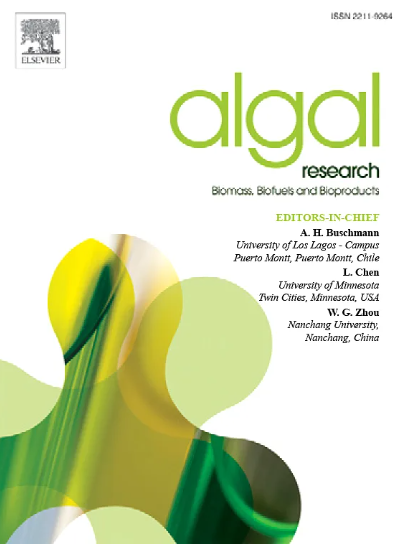甘露南c5 -外膜酶用于定制海藻酸盐修饰
IF 4.5
2区 生物学
Q1 BIOTECHNOLOGY & APPLIED MICROBIOLOGY
Algal Research-Biomass Biofuels and Bioproducts
Pub Date : 2025-06-03
DOI:10.1016/j.algal.2025.104126
引用次数: 0
摘要
海藻酸盐是一种线性多糖,由(1→4)-连接的β- d -甘露醛酸酯(M)和它的c5 -表聚体α- l -谷露醛酸酯(G)组成,主要分布在MM-、GG-或mg -交替残基块中。褐藻酸盐存在于褐藻(藻科海藻)的细胞壁中,但也由假单胞菌属和固氮菌属的某些细菌产生。由于其水胶体和凝胶特性,海藻酸盐被广泛应用于食品和保健品中,例如创可贴中的水分控制。海藻酸盐的凝胶特性是由g残基决定的,即所谓的GG块,通过与阳离子,特别是Ca2+的相互作用。在褐藻中,藻酸盐首先以聚m分子(甘露聚糖)的形式产生。在细胞壁适应和成熟过程中,m -残基被甘露聚糖C5-外膜酶(EC 5.1.3.37)修饰,通过催化C5基团的“翻转”,将部分m -残基转化为g -残基。虽然G:M比因大藻种类和地理位置而异,但成熟的藻酸盐通常含有更多的G残基,具有更好的凝胶性,而在平静水域养殖的棕色大藻,包括现在在北半球养殖的褐藻,通常具有较低的G:M比。利用微生物甘露聚糖c5 -外膜酶改善褐藻的凝胶化性能,从而提高褐藻酸盐的应用价值。不同微生物甘露聚糖c5 -外膜酶的结构和催化性能,特别是固氮菌甘露聚糖c5 -外膜酶的结构和催化性能已经被研究了几十年。最近,广泛的产品分析和重组大藻c5 -外膜酶的生产也有报道。在这篇综述中,我们详细介绍了甘露聚糖c5 -外膜酶,包括微生物酶、大藻酶和突变酶,重点介绍了反应机制、酶的类型、检测方法、模块化结构功能特性,以及反应产物的组成。研究结果提供了如何微小的变化可以塑造酶的功能和海藻酸盐组成的概述。本文章由计算机程序翻译,如有差异,请以英文原文为准。
Mannuronan C5-epimerases for tailored seaweed alginate modification
Alginate is a linear polysaccharide composed of (1 → 4)-linked β-D-mannuronate (M) and its C5-epimer α-L-guluronate (G) distributed in blocks of mainly MM-, GG- or alternating MG-residues. Alginate is found in the cell walls of brown macroalgae (seaweed, class Phaeophyceae), but is also produced by certain bacterial species within the Pseudomonas and Azotobacter genera. Due to its hydrocolloid and gelation properties, alginate is widely used in foods and healthcare products, e.g. for moisture control in band-aids. The gelation properties of alginate are determined by the G-residues, i.e. the so-called GG blocks, through interactions with cations, particularly Ca2+. In brown macroalgae alginate is first produced as poly-M molecules (mannuronan). During cell wall adaptation and maturation, the M-residues are modified by mannuronan C5-epimerases, EC 5.1.3.37, which convert some of the M-residues to G-residues by catalyzing the “flipping” of the C5 group. While the G:M ratio varies by macroalgal species and geographic location, mature alginates usually contain more G-residues and have better gelation properties, whereas brown macroalgae cultivated in calm water, including those now farmed in the Northern Hemisphere, typically have a low G:M ratio. The interest in using microbial mannuronan C5-epimerases to improve the gelation properties and thus increase the application value of alginate from cultivated brown macroalgae is therefore increasing. The structure and catalytic properties of different microbial mannuronan C5-epimerases, especially those of Azotobacter vinelandii, have been studied for decades. Recently, extensive product profiling and recombinant production of macroalgal C5-epimerases have also been reported. In this review we present detailed descriptions of mannuronan C5-epimerases, including the microbial, macroalgal, and mutated enzymes characterized so far, focusing on reaction mechanisms, enzyme types, assays, modular structure-function properties, and not least reaction product composition. The findings provide an overview of how minor changes can shape enzyme function and alginate composition.
求助全文
通过发布文献求助,成功后即可免费获取论文全文。
去求助
来源期刊

Algal Research-Biomass Biofuels and Bioproducts
BIOTECHNOLOGY & APPLIED MICROBIOLOGY-
CiteScore
9.40
自引率
7.80%
发文量
332
期刊介绍:
Algal Research is an international phycology journal covering all areas of emerging technologies in algae biology, biomass production, cultivation, harvesting, extraction, bioproducts, biorefinery, engineering, and econometrics. Algae is defined to include cyanobacteria, microalgae, and protists and symbionts of interest in biotechnology. The journal publishes original research and reviews for the following scope: algal biology, including but not exclusive to: phylogeny, biodiversity, molecular traits, metabolic regulation, and genetic engineering, algal cultivation, e.g. phototrophic systems, heterotrophic systems, and mixotrophic systems, algal harvesting and extraction systems, biotechnology to convert algal biomass and components into biofuels and bioproducts, e.g., nutraceuticals, pharmaceuticals, animal feed, plastics, etc. algal products and their economic assessment
 求助内容:
求助内容: 应助结果提醒方式:
应助结果提醒方式:


